D Link DWLG122D1 Marvell USB Dongle User Manual DWLG122 manual 092705 indd
D Link Corporation Marvell USB Dongle DWLG122 manual 092705 indd
D Link >
Contents
- 1. Manual
- 2. Manual CD ROM
Manual

Manual
Building Networks for People
802.11g (2.4GHz)
Wireless G USB 2.0 Adapter
DWL-G122
D-Link AirPlus G
TM
Version 2.0
2
Contents
Package Contents ................................................................................ 3
Introduction ........................................................................................... 4
Features and Benefits .......................................................................... 5
Wireless Basics .................................................................................... 6
Installation Considerations ................................................................... 7
Getting Started ..................................................................................... 8
Using the Configuration Utility .............................................................11
Networking Basics .............................................................................. 22
Troubleshooting .................................................................................. 35
Technical Specifications ..................................................................... 38
Contacting Technical Support ............................................................. 40
Warranty ............................................................................................. 41
Registration ........................................................................................ 44
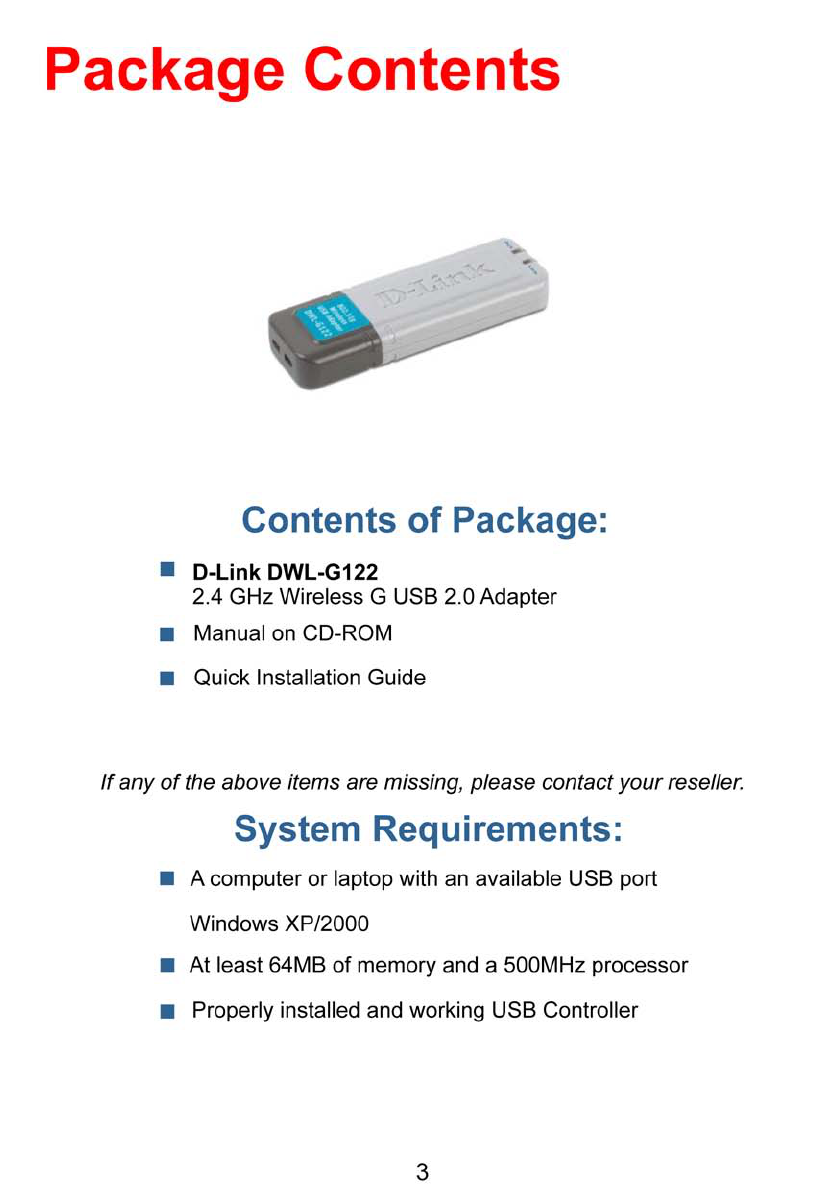
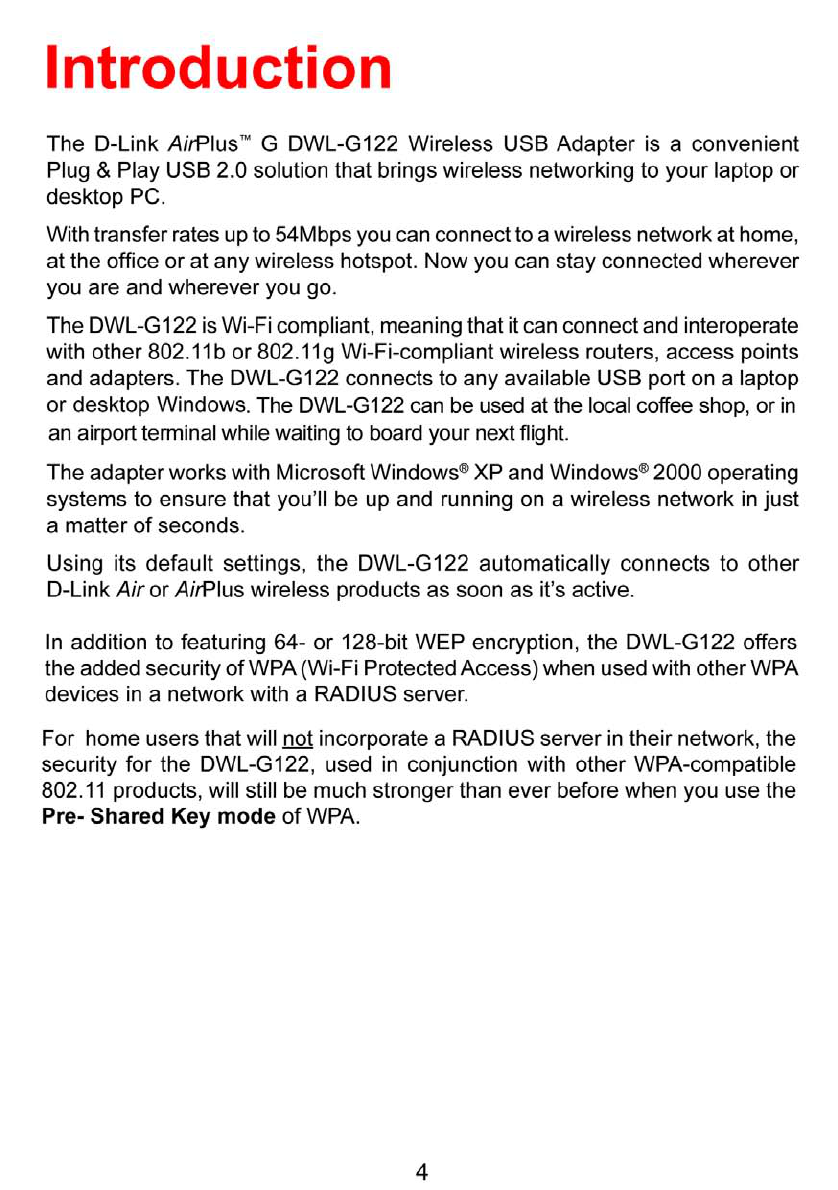
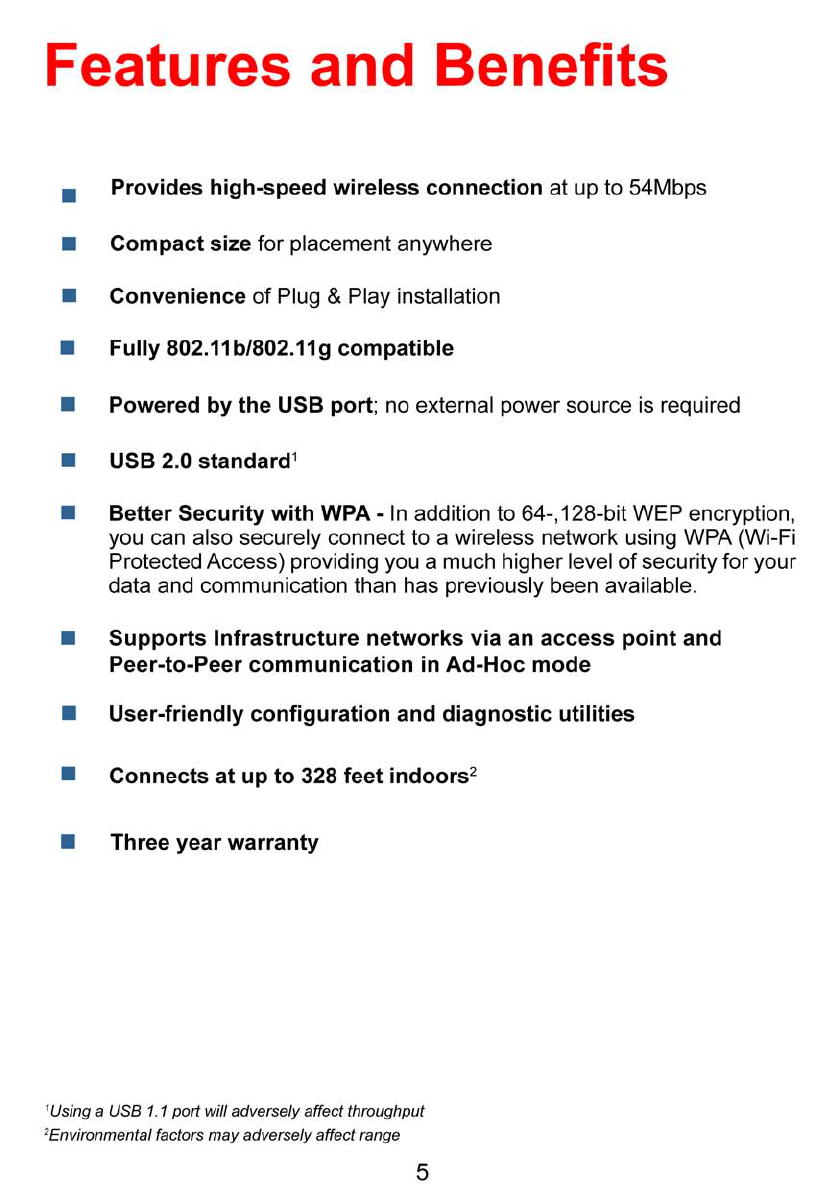
6
Wireless Basics
Wireless users can use the same applications they use on a wired network.
Wireless adapter cards used on laptop and desktop systems support the same
protocols as Ethernet adapter cards.
D-Link wireless products are based on industry standards to provide easy-to-use
and compatible high-speed wireless connectivity within your home, business or
public access wireless networks. D-Link wireless products will allow you access
to the data you want, when and where you want it. You will be able to enjoy the
freedom that wireless networking brings.
A wireless local area network (WLAN) is a computer network that transmits and
receives data with radio signals instead of wires. WLANs are used increasingly
in both home and office environments, and public areas such as airports, coffee
shops and universities. Innovative ways to utilize WLAN technology are helping
people to work and communicate more efficiently. Increased mobility and the
absence of cabling and other fixed infrastructure have proven to be beneficial
to many users.
People use WLAN technology for many different purposes:
Mobility - Productivity increases when people have access to data in any
location within the operating range of the WLAN. Management decisions based
on real-time information can significantly improve worker efficiency.
Low Implementation Costs - WLANs are easy to set up, manage, change
and relocate. Networks that frequently change can benefit from WLANs ease
of implementation. WLANs can operate in locations where installation of wiring
may be impractical.
Installation and Network Expansion - Installing a WLAN system can be fast
and easy and can eliminate the need to pull cable through walls and ceilings.
Wireless technology allows the network to go where wires cannot go - even
outside the home or office.
Inexpensive Solution - Wireless network devices are as competitively priced
as conventional Ethernet network devices.
Scalability - WLANs can be configured in a variety of ways to meet the needs
of specific applications and installations. Configurations are easily changed
and range from Peer-to-Peer networks suitable for a small number of users
to larger Infrastructure networks to accommodate hundreds or thousands of
users, depending on the number of wireless devices deployed.
7
Installation Considerations
The DWL-G122 lets you access your network using a wireless connection
from virtually anywhere within its operating range. Keep in mind, however, that
the number, thickness and location of walls, ceilings, or other objects that the
wireless signals must pass through, may limit the range. Typical ranges vary
depending on the types of materials and background RF (radio frequency) noise
in your home or business. The key to maximizing wireless range is to follow
these basic guidelines:
Keep your product away (at least 3-6 feet or 1-2 meters) from electrical
devices or appliances that generate RF noise.
4
Keep the number of walls and ceilings between the DWL-G122 and other
network devices to a minimum - each wall or ceiling can reduce your
DWL-G122’s range from 3-90 feet (1-30 meters.) Position your devices
so that the number of walls or ceilings is minimized.
1
Be aware of the direct line between network devices. A wall that is 1.5
feet thick (.5 meters), at a 45-degree angle appears to be almost 3 feet
(1 meter) thick. At a 2-degree angle it looks over 42 feet (14 meters)
thick! Position devices so that the signal will travel straight through a
wall or ceiling (instead of at an angle) for better reception.
2
Building materials can impede the wireless signal - a solid metal door
or aluminum studs may have a negative effect on range. Try to position
wireless devices and computers with wireless adapters so that the signal
passes through drywall or open doorways and not other materials.
3
Wireless Basics (continued)

8
Getting Started
With its default settings, the DWL-G122 will connect with other
D-Link AirPlus G products, right out of the box.
A wireless router - D-Link AirPlusTM G DI-524
A laptop computer with a D-Link AirPlus G DWL-G122
A desktop computer with a D-Link AirPlus G DWL-G122
A cable modem - D-Link DCM-201
There are basically two modes of networking:
Infrastructure – using an access point or router, such as the DI-624.
Ad-Hoc – directly connecting to another computer, for Peer-to-Peer
communication, using wireless network adapters on each computer, such
as two or more DWL-G122 Wireless Network USB adapters.
On the following pages we will show you an example of an Infrastructure
Network and an Ad-Hoc Network.
An Infrastructure network contains an access point or router. The Infrastructure
network example shown on the following page contains the following D-Link
network devices (your existing network may be comprised of other devices):
TM
TM
TM

9
You will need broadband Internet access (a cable or DSL-subscriber
line into your home or office).
Consult with your cable or DSL provider for proper installation of the
modem.
Connect the cable or DSL modem to your broadband router.
(See the Quick Installation Guide included with your router.)
Install the D-Link AirPlus™ G DWL-G122 Wireless USB adapter into
an available USB port on your desktop computer.
(See the Quick Installation Guide included with the DWL-G122.)
Getting Started (continued)
For a typical wireless setup at home (as shown above), please do the follow-
5
Setting up a Wireless Infrastructure Network
1
2
3
Install the D-Link AirPlus G DWL-G122 wireless USB adapter into an
available USB port on your laptop computer.
(See the Quick Installation Guide included with the DWL-G122.)
4
DWL-G122
DWL-G122
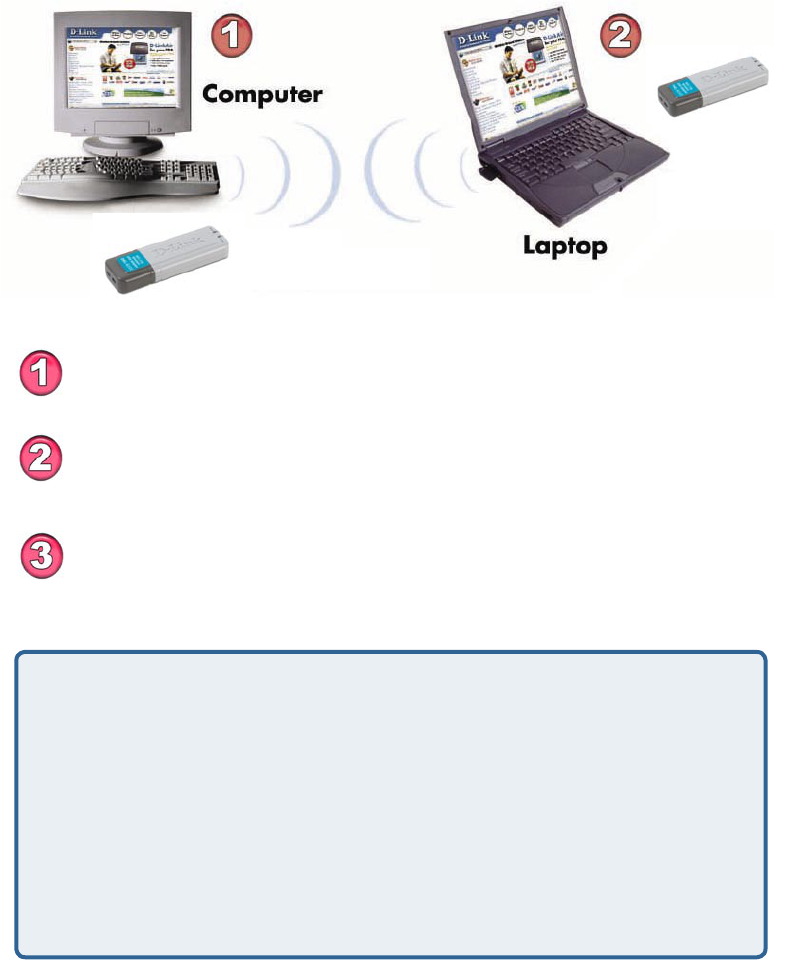
10
Getting Started (continued)
Setting up a Wireless Ad-Hoc Network
When assigning IP addresses to the computers on the network, please
remember that the IP address for each computer must be in the same
IP address range as all the computers in the network, and the subnet
mask must be exactly the same for all the computers in the network.
For example: If the first computer is assigned an IP address of 192.168.0.2
with a subnet mask of 255.255.255.0, then the second computer can be
assigned an IP address of 192.168.0.3 with a subnet mask of 255.255.255.0,
etc.
IMPORTANT: If computers or other devices are assigned the same
IP address, one or more of the devices may not be visible on the
IP Address
Install the D-Link AirPlus™ G DWL-G122 Wireless USB adapter into
the desktop computer. (See the Quick Installation Guide included with
the product.)
Set the wireless configuration for the adapters to Ad-Hoc mode, set
the adapters to the same channel, and assign an IP address to each
computer on the Ad-Hoc network.
Install the D-Link AirPlus™ G DWL-G122 Wireless USB adapter into
the laptop computer. (See the Quick Installation Guide included with
the product.)
DWL-G122
Wireless USB Adapter
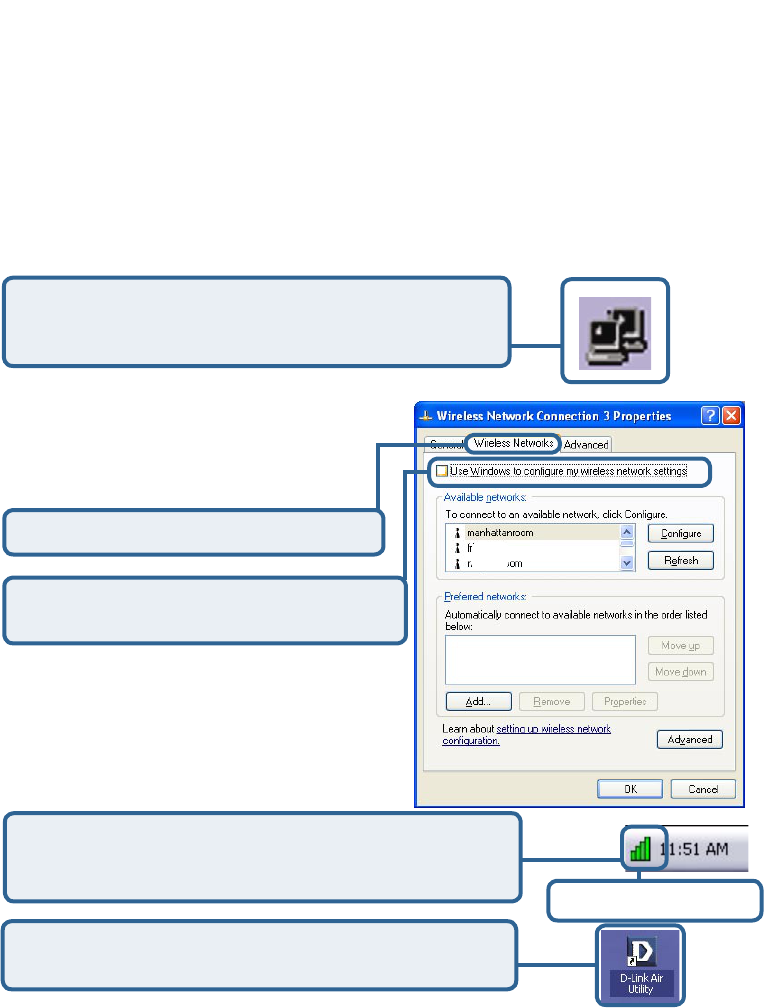
11
Select the Wireless Networks tab.
Uncheck the box in the properties window
that enables windows configuration.
The D-Link AirPlus™ G uses the Configuration Utility as the management
software. The utility provides the user an easy interface to change any settings
related to the wireless adapter. After you have completed the installation of
the DWL-G122 (refer to the Quick Installation Guide that came with your
purchase) whenever you start the computer, the Configuration Utility starts
automatically and the system tray icon is loaded in the toolbar (see illustration
below.*) Clicking on the utility icon will start the Configuration Utility. Another
way to start the Configuration Utility is to click on Start>Programs>D-Link
AirPlus G >D-Link AirPlus™ G Utility.
Using the Configuration
If you are using Windows XP, you can use either the Zero Configuration Utility
or the D-Link Configuration Utility.
If the icon does not display in the taskbar, then click on
this icon on your desktop to open.
To use the D-Link Configuration Utility with XP, right-click
on the wireless network icon in the taskbar in the lower
right-hand corner of your computer screen.
In the window that appears, select
View Available Wireless Networks
and click the Advanced button. The
screen at right will appear.
After you have done this, you can then use the D-Link
Configuration Utility with XP by clicking on the D-Link
Configuration Utility icon. *Configuration Utility icon in
the system tray
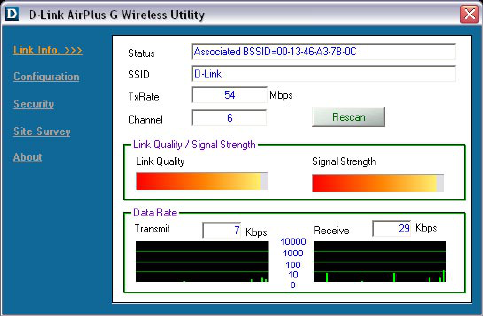
12
Using the Configuration Utility (continued)
Link Info
SSID:
The Service Set Identifier is
the name assigned to the
wireless network.
The factory SSID setting is
default.
Tx Rate:
The default setting is Auto; Tx Rate settings are automatically determined
for an optimal speed up to a maximum of 54Mbps.
Status:
Displays the MAC address
of the access point or
router to which the
DWL-G122 is associated.
Channel:
The default setting is Auto. The channel selection is automatically detemined
by the DWL-G122.
Link Quality/Signal Strength:
Displays the signal strength and the link quality of the DWL-G122’s wireless
connection to the access point or router.
Data Rate:
Displays the statistics of the data packets that are transmitted and received.
Rescan Button:
Rescans for the strongest signal with the current SSID and associates with
that access point or router.
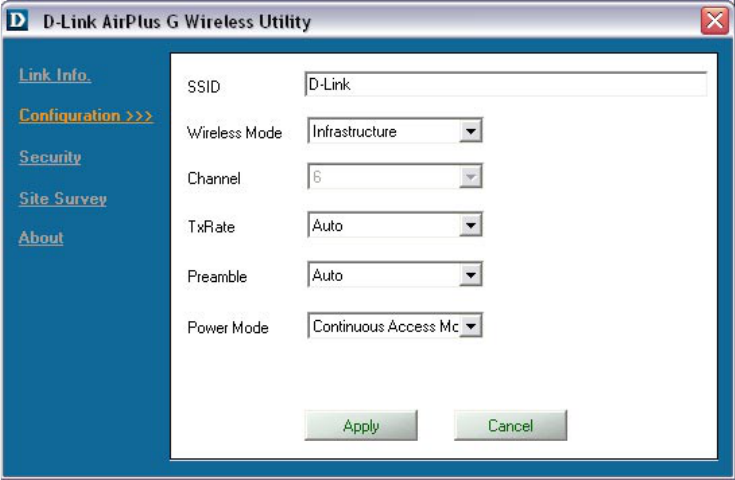
13
Configuration
Using the Configuration Utility (continued)
Wireless Mode:
SSID:
Service Set Identifier is a name that identifies a wireless network. Access points
and wireless devices attempting to connect to a specific WLAN (Wireless Local
Area Network) must use the same SSID. The default setting is default.
Click on the pull-down menu; select from the following options:
Infrastructure - connecting to the WLAN using an access point. (This is
the default setting).
Ad-Hoc – wireless mode used when connecting directly to a computer
equipped with a wireless adapter in a Peer-to-Peer environment.
Tx Rate:
The default setting is Auto; Tx Rate settings are automatically determined
for an optimal speed up to a maximum of 54Mbps.
Channel:
The default setting is Auto. The channel selection is automatically detemined
by the DWL-G122.
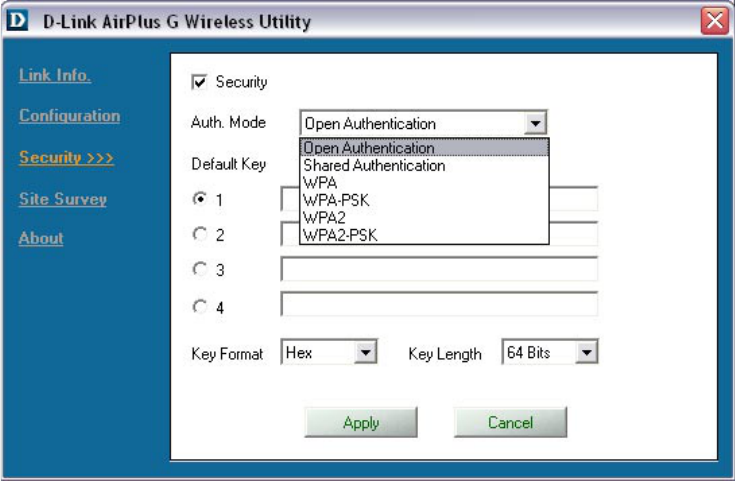
14
Using the Configuration Utility (continued)
Power Mode:
Disable -This default setting consumes the most power.
Enable - This setting consumes the least power.
Preamble:
The default setting is Auto. The preamble selection is automatically detemined
by the DWL-G122.
Security
Keys 1-4:
Select the default key.
Security:
Check this checkbox if you would like security.
Auth. Mode:
Select Open/Shared Authentication, WPA, WPA-PSK, WPA2, or WPA2-PSK.
Key Format:
Select either Hex or ASCII.
Key Length:
Select either 64 Bits or 128 Bits.

15
Using the Configuration Utility (continued)
Hexadecimal digits consist of the numbers 0-9 and the letters A-F.
ASCII (American Standard Code for Information Interchange) is a code for
representing English letters as numbers from 0-127.
Site Survey
Available Network:
The top section of the window displays the Available Networks. Scroll up and
down the list and highlight the network to which you wish to connect. Click on
the Connect button.
Profile:
In the lower half of the screen, you can manage the profiles that you have
created for the wireless network at home, at the office and in public places.
Scroll up and down and highlight the profile that you wish to configure. You can
Add or Remove a profile, or configure the Properties of the profile in order to
connect with an available network.
16
Refresh:
Click on Refresh to get the most updated list of available networks.
Using the Configuration Utility (continued)
Connect:
Highlight an existing network and click Connect; the connect window on the
next page will appear.
Add:
Click Add and the screen on the next page will appear.
Remove:
Highlight a network profile; click Remove to remove a network from the profile
list.
Properties:
Highlight a network profile; click Properties and the screen on the next page
will appear.
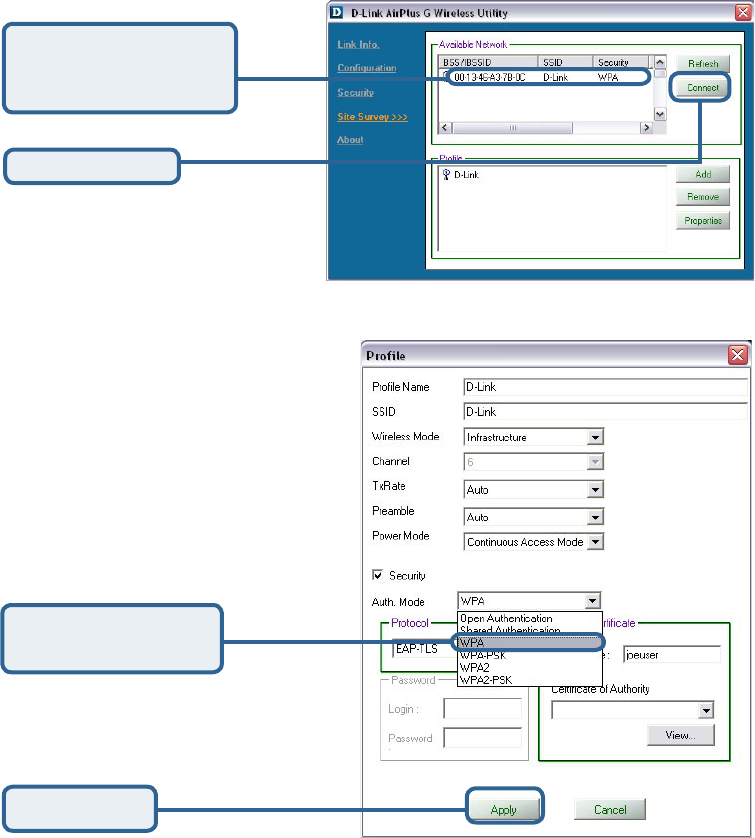
17
Using the Configuration Utility (continued)
Authentication > WPA
Select the available
network to which you
want to connect.
Click Connect.
Click Apply.
Select WPA in the
Auth. Mode field.
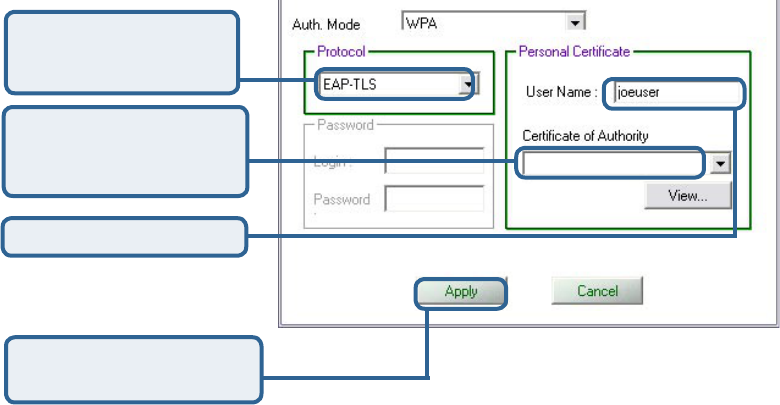
18
Using the Configuration Utility (continued)
Authentication > WPA
Select the Protocol
type here.
Enter the User Name.
Click Apply to save the
changes.
Leave the Certificate
of Authority field
blank.
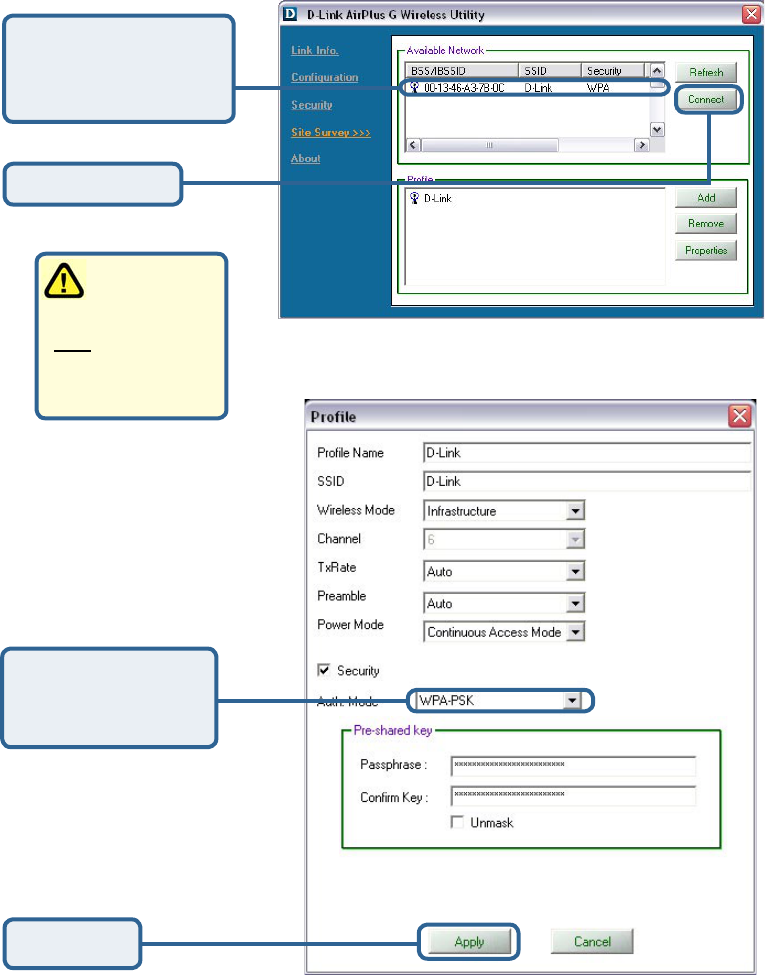
19
Using the Configuration Utility (continued)
Authentication > WPA-PSK
Click Connect.
Select WPA-PSK
in the Auth. Mode
field.
Select the available
network to which you
want to connect.
WPA-PSK does
not require a
RADIUS Server
in the network.
Click Apply.
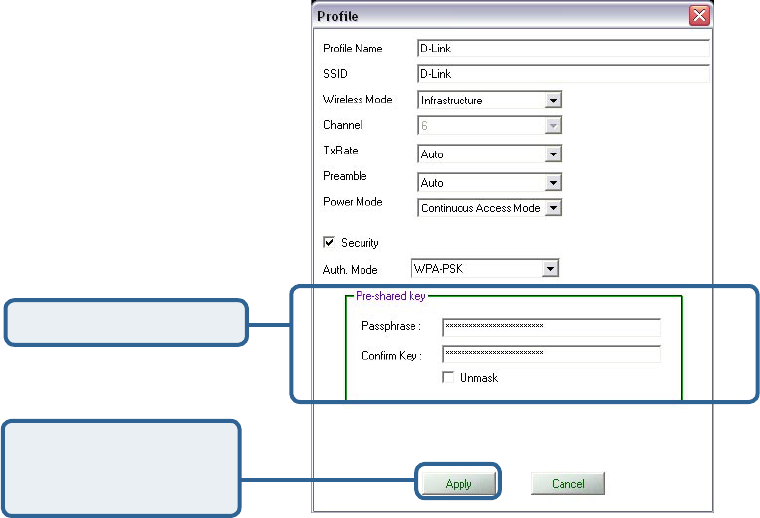
20
Using the Configuration Utility (continued)
Authentication > WPA-PSK (continued)
Enter the Passphrase.
Click Apply.
The configuration is
done.
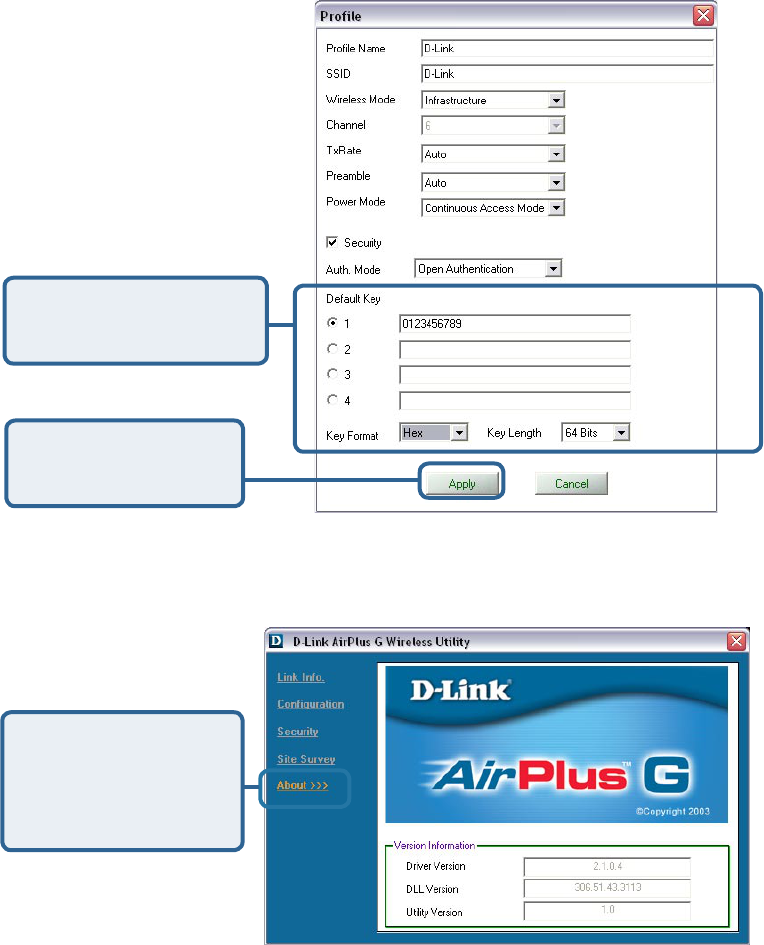
21
Using the Configuration Utility (continued)
Authentication > Open Authentication
Enter the Default Key and
select the Key Format
and Key Length.
Click Apply.
The configuration is
done.
About
The About screen gives
you the MAC address,
Utility Version and the
Driver Version of the
DWL-G122.

22
Using the Network Setup Wizard in Windows XP
In this section you will learn how to establish a network at home or work,
using Microsoft Windows XP.
Note: Please refer to websites such as http://www.homenethelp.com
and http://www.microsoft.com/windows2000 for information about networking
computers using Windows XP/2000.
Go to Start>Control Panel>Network Connections.
Select Set up a home or small office network.
Networking Basics
When this screen appears, click Next.
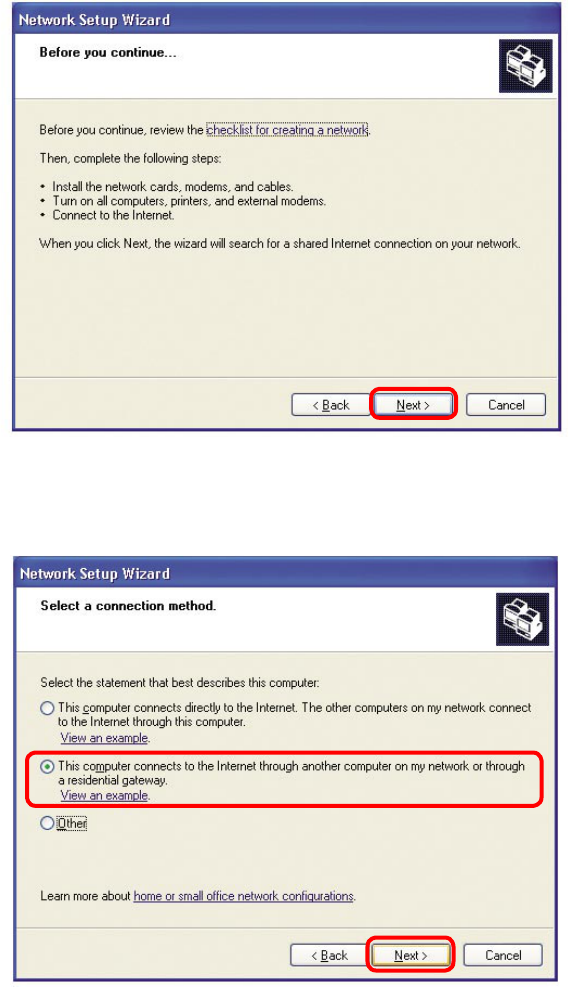
23
Please follow all the instructions in this window:
Networking Basics (continued)
Click Next.
In the following window, select the best description of your computer. If your
computer connects to the Internet through a router, select the second option
as shown.
Click Next.
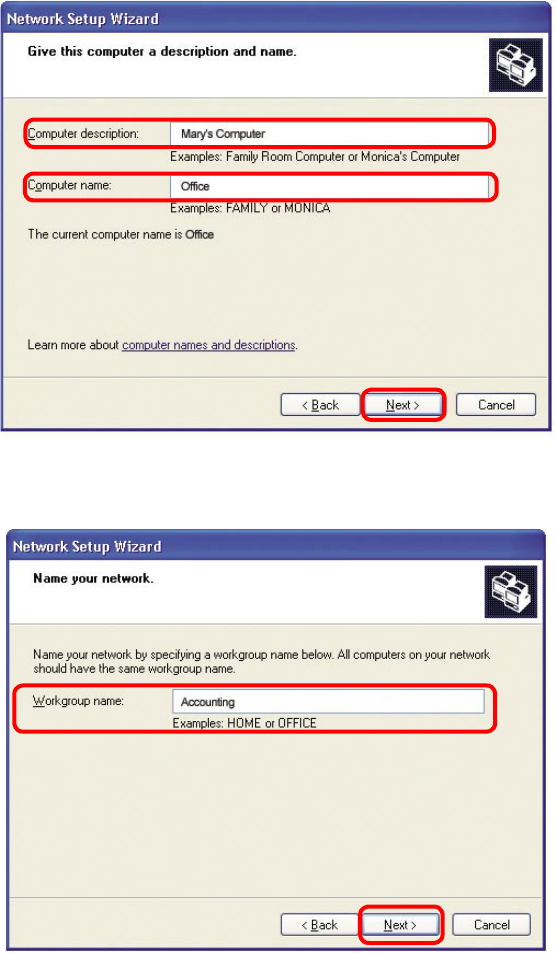
24
Enter a Computer description and a Computer name (optional.)
Networking Basics (continued)
Click Next.
Enter a Workgroup name. All computers on your network should have the
same Workgroup name.
Click Next.
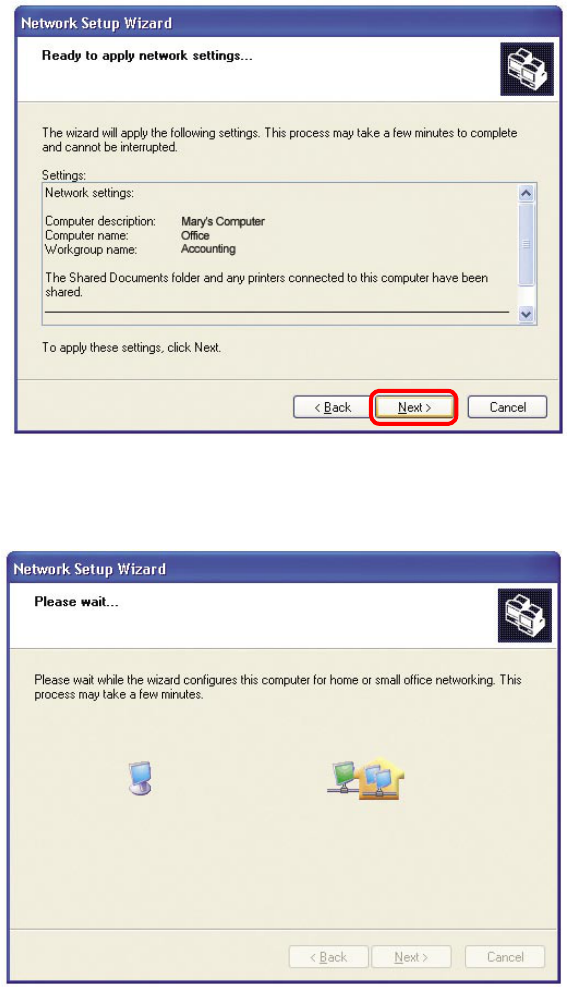
25
Please wait while the Network Setup Wizard applies the changes.
Networking Basics (continued)
When the changes are complete, click Next.
Please wait while the Network Setup Wizard configures the computer.
This may take a few minutes.
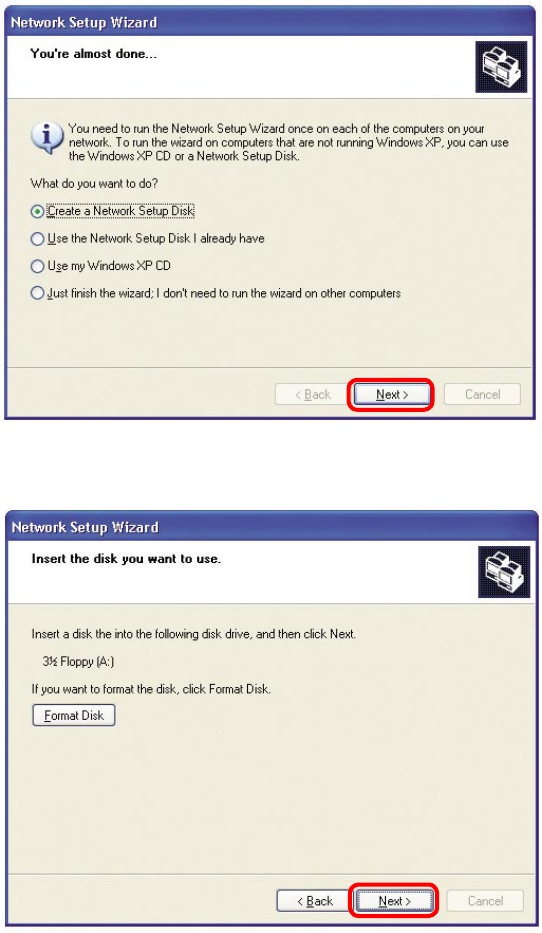
26
In the window below, select the option that fits your needs. In this example,
Create a Network Setup Disk has been selected. You will run this disk on
each of the computers on your network. Click Next.
Insert a disk into the Floppy Disk Drive, in this case drive A.
Networking Basics (continued)
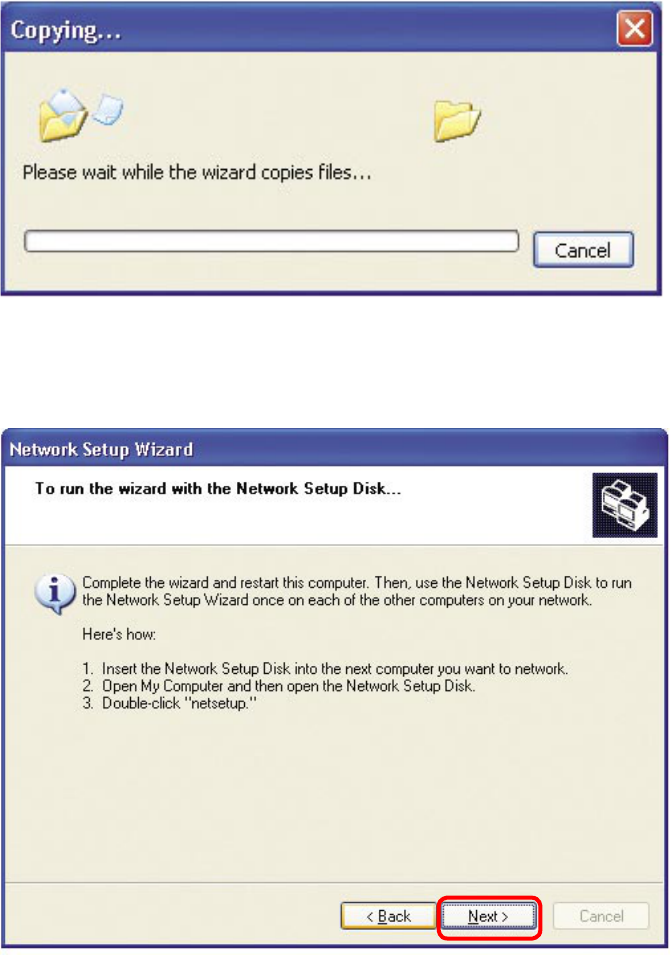
27
Please read the information under Here’s how in the screen below. After you
complete the Network Setup Wizard you will use the Network Setup Disk to
run the Network Setup Wizard once on each of the computers on your
network. To continue click Next.
Networking Basics (continued)
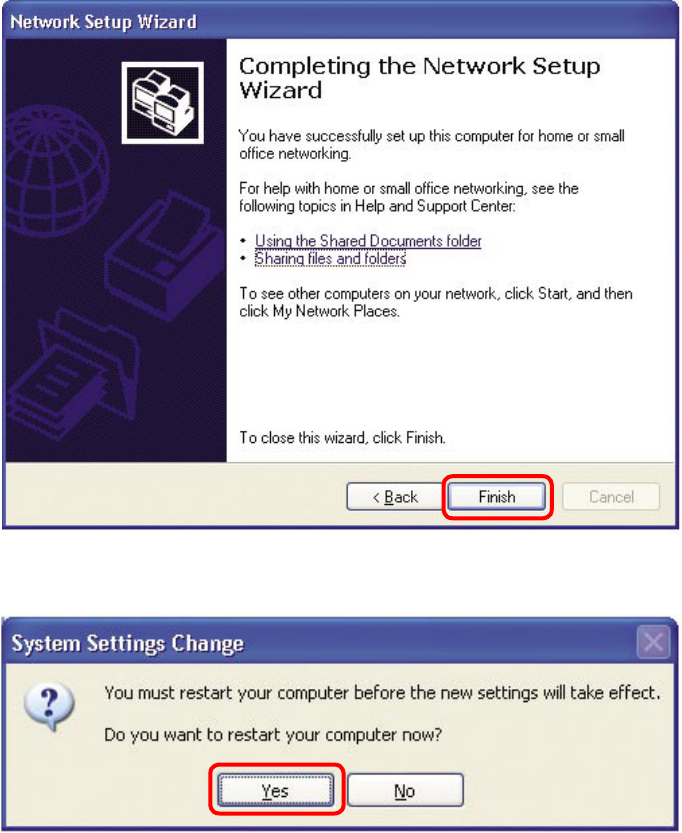
28
Please read the information on this screen, then click Finish to complete the
Network Setup Wizard.
The new settings will take effect when you restart the computer. Click Yes to
restart the computer.
You have completed configuring this computer. Next, you will need to run the
Network Setup Disk on all the other computers on your network. After running
the Network Setup Disk on all your computers, your new wireless network will
be ready to use.
Networking Basics (continued)
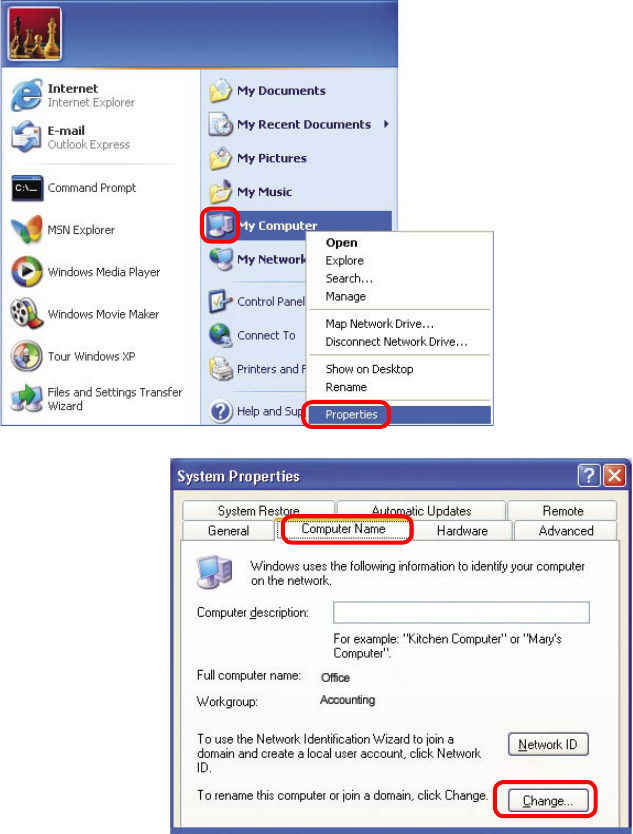
29
Click Start (in the lower left corner of the screen).
Right-click on My Computer.
Select Properties.
Select the Computer
Name Tab in the
System Properties win-
dow.
You may enter a
Computer Description
if you wish; this field is
optional.
To rename the computer
and join a domain, click
Change.
Networking Basics (continued)
Naming Your Computer
To name your computer in Windows XP, please follow these directions:
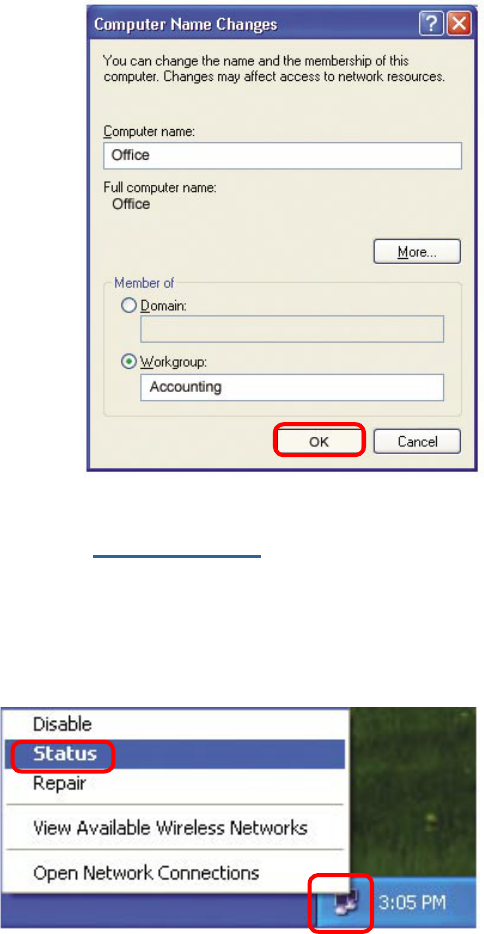
30
In this window, enter the
Computer name.
Select Workgroup and
enter the name of the
Workgroup.
All computers on your
network must have the
same Workgroup name.
Click OK.
Checking the IP Address in Windows XP
All wireless adapter-equipped computers in your network must be in the same IP
address range (see Getting Started in this manual for a definition of IP address
range.) To check on the IP address of an adapter, please do the
following:
Right-click on the
Local Area Con-
nection icon in
the task bar.
Click on Status.
Networking Basics (continued)
Naming Your Computer
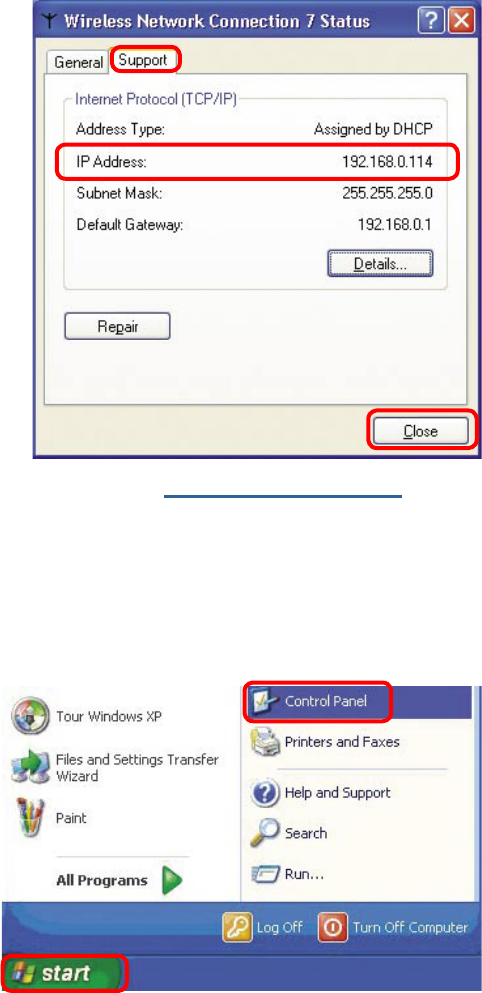
31
This window will appear.
Click the Support
tab.
Click Close.
Assigning a Static IP Address in Windows XP/2000
Note: Many broadband routers will automatically assign IP addresses to the
computers on the network, using DHCP (Dynamic Host Configuration Protocol)
technology. If you are using a DHCP-capable router you will not need to
assign static IP addresses.
If you are not using a DHCP capable router, or you need to assign a static IP
address, please follow these instructions:
Go to Start.
Click on
Control Panel.
Networking Basics (continued)
Checking the IP Address in Windows XP
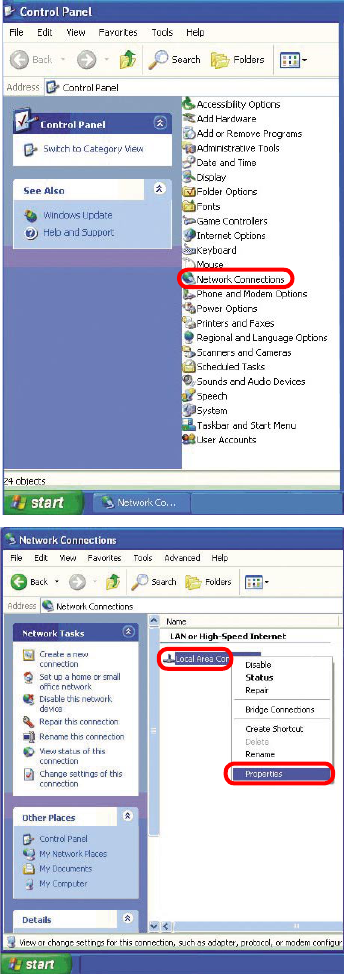
32
Double-click on Network
Connections.
Click on Properties.
Right-click on Local Area
Connections.
Networking Basics (continued)
Assigning a Static IP Address in Windows XP/2000
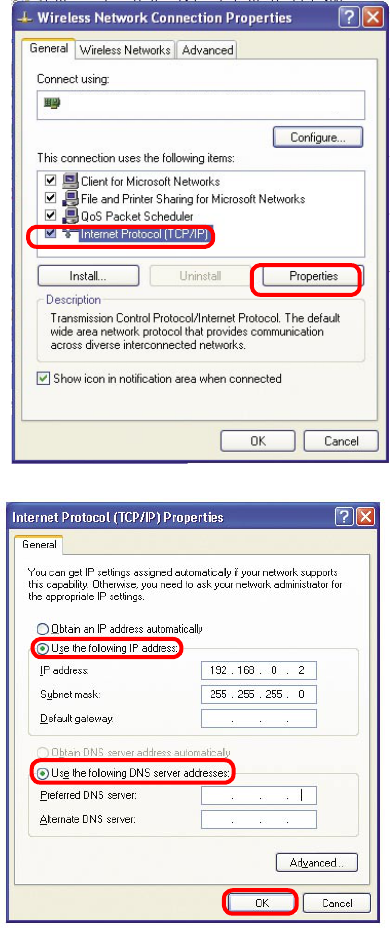
33
D-Link AirPlus G DWL-G122 Wireless USB Adapter
Input your IP address and
subnet mask. (The IP
addresses on your network
must be within the same
range. For example, if
one computer has an IP
address of 192.168.0.2,
the other computers should
have IP addresses that are
sequential, like 192.168.0.3
and 192.168.0.4. The
subnet mask must be the
same for all the computers
on the network.)
Input your DNS server
addresses. (Note: If
you are entering a DNS
server, you must enter
the IP address of the
Default Gateway.)
The DNS server information will be
supplied by your ISP (Internet Service
Provider.)
Click OK.
Click on Internet
Protocol (TCP/IP).
Click Properties.
Networking Basics (continued)
Assigning a Static IP Address in Windows XP/2000
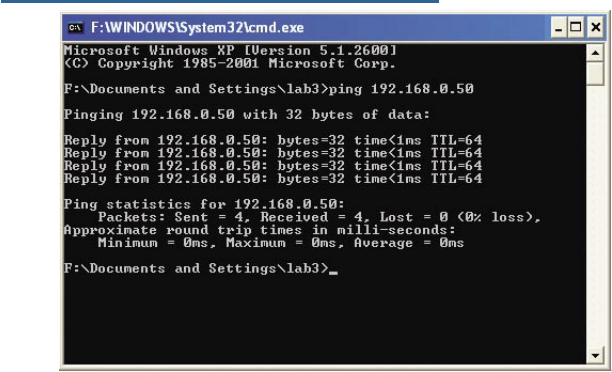
34
Checking the Wireless Connection
by Pinging in Windows XP and 2000
Go to Start > Run > type cmd. A window similar to this one will appear. Type
ping xxx.xxx.xxx.xxx, where xxx is the IP address of the wireless router or
access point. A good wireless connection will show four replies from the
wireless router or access point, as shown.
Networking Basics (continued)
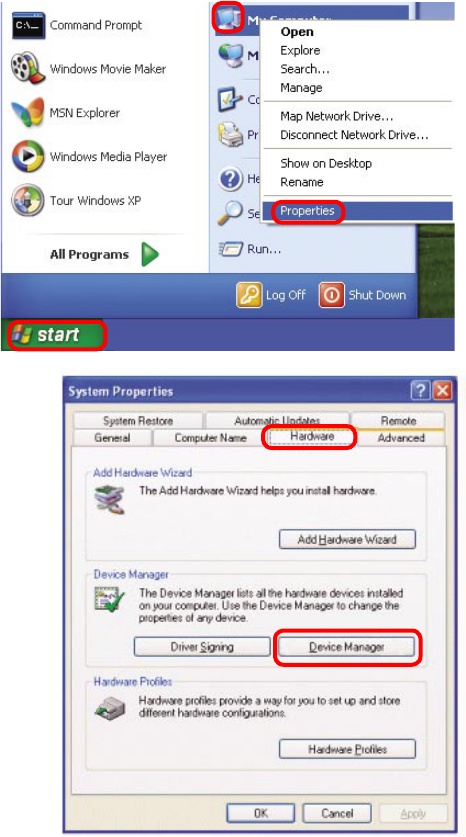
35
1. How do I check to see that the drivers for the DWL-G122 are
installed properly?
Click Device
Manager.
Select the
Hardware
Tab.
Troubleshooting
Go to Start >
My Computer >
Properties.
This chapter provides solutions to problems that can occur during the installation
and operation of the DWL-G122. Read the following descriptions if you
are having problems. (The examples below are illustrated in Windows XP. If
you have another operating system, these solutions will still apply although the
appearance on your computer screen may differ.)
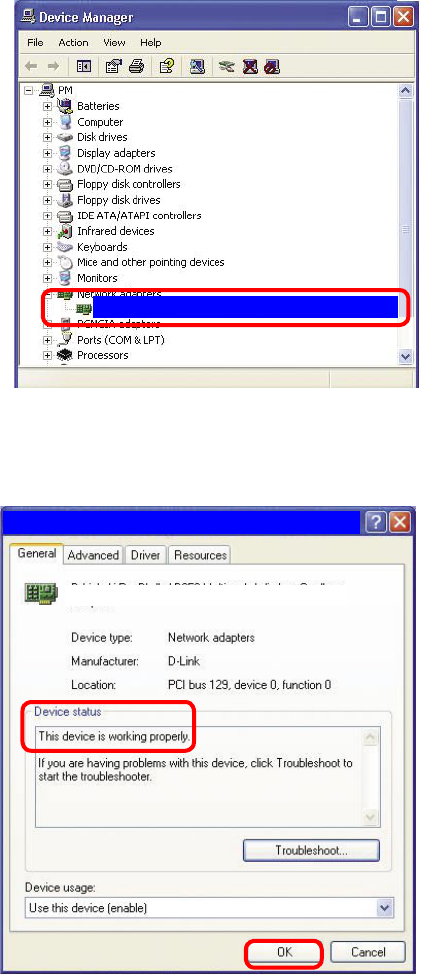
36
Troubleshooting (continued)
Double-click on
Network Adapters.
Right-click on
D-Link AirPlus G
DWL-G122 Wireless
USB Adapter.
Select Properties to
check that the drivers
are installed properly.
Look under Device
Status to check that
the device is working
properly.
Click OK.
D-Link AirPlus G DWL-G122 Wireless USB Adapter
D-Link AirPlus G DWL-G122 Wireless USB Adapter
D-Link AirPlus G DWL-G122 Wireless USB Adapter
37
Troubleshooting (continued)
2. What variables may cause my wireless products to lose reception?
D-Link products let you access your network from virtually anywhere you want.
However, the positioning of the products within your environment will affect the
wireless range. Please refer to Installation Considerations in the Wireless
Basics section of this manual for further information about the most
advantageous placement of your D-Link wireless products.
3. Why does my wireless connection keep dropping?
4. Why can’t I get a wireless connection?
If you have enabled encryption on the DWL-G122, you must also enable
encryption on all wireless devices in the network in order to establish a
wireless connection.
If you are using 2.4GHz cordless phones, X-10 equipment or other home
security systems, ceiling fans, and lights, your wireless connection will
degrade dramatically or drop altogether. Try changing the channel on
your router, access point and wireless adapter to a different channel to
avoid interference.
Keep your product away (at least 3-6 feet) from electrical devices that
generate RF noise, like microwaves, monitors, electric motors, etc.
The encryption settings are: 64- or 128-bit. Make sure that the
encryption bit level is the same on the router and the DWL-G122.
Make sure that the SSID on the wireless router (if you have one in your
network) and the DWL-G122 are exactly the same. If they are not,
wireless connection will not be established. The default SSID is
default.
38
IEEE 802.11g
Technical Specifications
USB 2.01
Standard
80% maximum, non-condensing
Humidity:
Antenna Type:
Omni-directional
Modulation Technology:
54, 48, 36,24, 18, 11, 9, 6 5.5, 2, 1Mbps (with Automatic Fallback)
Data Rates*:
2.4GHz to 2.462GHz
Frequency Range:
Indoors: Up to 328 feet (100 meters)
Range:2
IEEE 802.11b
USB 2.0
Bus Type
Temperature
Operating: 0ºC to 40ºC (32ºF to 104ºF)
Storing: -20ºC to 75ºC (4ºF to 167ºF)
Orthogonal Frequency Division Multiplexing (OFDM)
Complimentary Code Keying (CCK)
64-, 128-bit WEP
WPA - Wi-Fi Protected Access
Security:
CSMA/CA with ACK
Media Access Control:
Outdoors: Up to 1,312 feet (400 meters)
2 - Environmental factors may adversely affect wireless signal range
* - Maximum wireless signal rate derived from IEEE Standard 802.11_ specifications. Actual data throughput will vary. Network conditions
and environmental factors, including volume of network traffic, building materials and construction, and network overhead, lower actual data
throughput rate. Environmental factors may adversely affect wireless signal range.
1 - Using a USB 1.1 port will adversely affect range
39
Technical Specifications (continued)
Receiver Sensitivity:
L = 3.3 inches
W = 2.1 inches
H = 0.2 inches
Physical Dimensions:
5.5Mbps CCK
2Mbps QPSK
1Mbps BPSK
11Mbps OFDM
9Mbps OFDM
6Mbps OFDM
24Mbps OFDM
18Mbps OFDM
12Mbps OFDM
54Mbps OFDM
48Mbps OFDM
36Mbps OFDM
14Bm +/-2dB
Transmitter Output Power:
0.021 lb. (4.4g)
Weight:
3 years
Warranty:
FCC part 15b
Certifications:
D-Link AirPlusTM G products can transfer data up to 5 times faster than standard 802.11b networks. They are also interoperable with 802.11b
compliant wireless devices.

40
Technical Support
You can find software updates and user documentation on the D-Link website.
D-Link provides free technical support for customers within the United States and
within Canada for the duration of the warranty period on this product.
U.S. and Canadian customers can contact D-Link Technical Support through our
website, or by phone.
Tech Support for customers within the United States:
D-Link Technical Support over the Telephone:
(877) 453-5465
24 hours a day, seven days a week.
D-Link Technical Support over the Internet:
http://support.dlink.com
email:support@dlink.com
Tech Support for customers within Canada:
D-Link Technical Support over the Telephone:
(800) 361-5265
Monday to Friday 7:30am to 9:00pm EST
D-Link Technical Support over the Internet:
http://support.dlink.ca
email:support@dlink.ca

41
Subject to the terms and conditions set forth herein, D-Link Systems, Inc. (“D-Link”) provides this
Limited Warranty:
Only to the person or entity that originally purchased the product from D-Link or its authorized
reseller or distributor, and
Only for products purchased and delivered within the fifty states of the United States, the District of
Columbia, U.S. Possessions or Protectorates, U.S. Military Installations, or addresses with an APO
or FPO.
Limited Warranty: D-Link warrants that the hardware portion of the D-Link product described below
(“Hardware”) will be free from material defects in workmanship and materials under normal use from the
date of original retail purchase of the product, for the period set forth below (“Warranty Period”), except
as otherwise stated herein.
Hardware (excluding power supplies and fans): Three (3) years
Power supplies and fans: One (1) year
Spare parts and spare kits: Ninety (90) days
The customer's sole and exclusive remedy and the entire liability of D-Link and its suppliers under this
Limited Warranty will be, at D-Link’s option, to repair or replace the defective Hardware during the
Warranty Period at no charge to the original owner or to refund the actual purchase price paid. Any
repair or replacement will be rendered by D-Link at an Authorized D-Link Service Office. The
replacement hardware need not be new or have an identical make, model or part. D-Link may, at its
option, replace the defective Hardware or any part thereof with any reconditioned product that D-Link
reasonably determines is substantially equivalent (or superior) in all material respects to the defective
Hardware. Repaired or replacement hardware will be warranted for the remainder of the original
Warranty Period or ninety (90) days, whichever is longer, and is subject to the same limitations and
exclusions. If a material defect is incapable of correction, or if D-Link determines that it is not practical
to repair or replace the defective Hardware, the actual price paid by the original purchaser for the
defective Hardware will be refunded by D-Link upon return to D-Link of the defective Hardware. All
Hardware or part thereof that is replaced by D-Link, or for which the purchase price is refunded, shall
become the property of D-Link upon replacement or refund.
Limited Software Warranty: D-Link warrants that the software portion of the product (“Software”) will
substantially conform to D-Link’s then current functional specifications for the Software, as set forth in
the applicable documentation, from the date of original retail purchase of the Software for a period of
ninety (90) days (“Software Warranty Period”), provided that the Software is properly installed on
approved hardware and operated as contemplated in its documentation. D-Link further warrants that,
during the Software Warranty Period, the magnetic media on which D-Link delivers the Software will be
free of physical defects. The customer's sole and exclusive remedy and the entire liability of D-Link and
its suppliers under this Limited Warranty will be, at D-Link’s option, to replace the non-conforming
Software (or defective media) with software that substantially conforms to D-Link’s functional
specifications for the Software or to refund the portion of the actual purchase price paid that is
attributable to the Software. Except as otherwise agreed by D-Link in writing, the replacement Software
is provided only to the original licensee, and is subject to the terms and conditions of the license granted
by D-Link for the Software. Replacement Software will be warranted for the remainder of the original
Warranty Period and is subject to the same limitations and exclusions. If a material non-conformance is
incapable of correction, or if D-Link determines in its sole discretion that it is not practical to replace the
non-conforming Software, the price paid by the original licensee for the non-conforming Software will be
refunded by D-Link; provided that the non-conforming Software (and all copies thereof) is first returned
to D-Link. The license granted respecting any Software for which a refund is given automatically
terminates.
Non-Applicability of Warranty: The Limited Warranty provided hereunder for Hardware and Software
portions of D-Link's products will not be applied to and does not cover any refurbished product and any
product purchased through the inventory clearance or liquidation sale or other sales in which D-Link, the
sellers, or the liquidators expressly disclaim their warranty obligation pertaining to the product and in that
case, the product is being sold "As-Is" without any warranty whatsoever including, without limitation, the
Limited Warranty as described herein, notwithstanding anything stated herein to the contrary.

42
• The customer must submit with the product as part of the claim a written description of the Hardware
defect or Software nonconformance in sufficient detail to allow D-Link to confirm the same.
• The original product owner must obtain a Return Material Authorization (“RMA”) number from
the Authorized D-Link Service Office and, if requested, provide written proof of purchase of the
product (such as a copy of the dated purchase invoice for the product) before the warranty service
is provided.
• After an RMA number is issued, the defective product must be packaged securely in the original
or other suitable shipping package to ensure that it will not be damaged in transit, and the RMA
number must be prominently marked on the outside of the package. Do not include any manuals
or accessories in the shipping package. D-Link will only replace the defective portion of the Product
and will not ship back any accessories.
• The customer is responsible for all in-bound shipping charges to D-Link. No Cash on Delivery
(“COD”) is allowed. Products sent COD will either be rejected by D-Link or become the property
of D-Link. Products shall be fully insured by the customer. D-Link will not be held responsible for
any packages that are lost in transit to D-Link. The repaired or replaced packages will be shipped
to the customer via UPS Ground or any common carrier selected by D-Link, with shipping charges
prepaid. Expedited shipping is available if shipping charges are prepaid by the customer and upon
request.
• Return Merchandise Ship-To Address
USA: 17595 Mt. Herrmann St., Fountain Valley, CA 92708
Canada: 2180 Winston Park Drive, Oakville, ON, L6H 5W1 (Visit http://www.dlink.ca for detailed warranty
information within Canada)
D-Link may reject or return any product that is not packaged and shipped in strict compliance with the
foregoing requirements, or for which an RMA number is not visible from the outside of the package. The
product owner agrees to pay D-Link’s reasonable handling and return shipping charges for any product that
is not packaged and shipped in accordance with the foregoing requirements, or that is determined by D-Link
not to be defective or non-conforming.
What Is Not Covered: This limited warranty provided by D-Link does not cover: Products, if in D-Link’s
judgment, have been subjected to abuse, accident, alteration, modification, tampering, negligence, misuse,
faulty installation, lack of reasonable care, repair or service in any way that is not contemplated in the
documentation for the product, or if the model or serial number has been altered, tampered with, defaced or
removed; Initial installation, installation and removal of the product for repair, and shipping costs; Operational
adjustments covered in the operating manual for the product, and normal maintenance; Damage that occurs
in shipment, due to act of God, failures due to power surge, and cosmetic damage; Any hardware, software,
firmware or other products or services provided by anyone other than D-Link; Products that have been
purchased from inventory clearance or liquidation sales or other sales in which D-Link, the sellers, or the
liquidators expressly disclaim their warranty obligation pertaining to the product. Repair by anyone other
than D-Link or an Authorized D-Link Service Office will void this Warranty.
Disclaimer of Other Warranties: EXCEPT FOR THE LIMITED WARRANTY SPECIFIED HEREIN, THE
PRODUCT IS PROVIDED “AS-IS” WITHOUT ANY WARRANTY OF ANY KIND WHATSOEVER INCLUDING,
WITHOUT LIMITATION, ANY WARRANTY OF MERCHANTABILITY, FITNESS FOR A PARTICULAR
PURPOSE AND NON-INFRINGEMENT. IF ANY IMPLIED WARRANTY CANNOT BE DISCLAIMED IN ANY
TERRITORY WHERE A PRODUCT IS SOLD, THE DURATION OF SUCH IMPLIED WARRANTY SHALL BE
LIMITED TO NINETY (90) DAYS. EXCEPT AS EXPRESSLY COVERED UNDER THE LIMITED WARRANTY
PROVIDED HEREIN, THE ENTIRE RISK AS TO THE QUALITY, SELECTION AND PERFORMANCE OF
THE PRODUCT IS WITH THE PURCHASER OF THE PRODUCT.
Limitation of Liability: TO THE MAXIMUM EXTENT PERMITTED BY LAW, D-LINK IS NOT LIABLE UNDER
ANY CONTRACT, NEGLIGENCE, STRICT LIABILITY OR OTHER LEGAL OR EQUITABLE THEORY
FOR ANY LOSS OF USE OF THE PRODUCT, INCONVENIENCE OR DAMAGES OF ANY CHARACTER,
WHETHER DIRECT, SPECIAL, INCIDENTAL OR CONSEQUENTIAL (INCLUDING, BUT NOT LIMITED TO,
DAMAGES FOR LOSS OF GOODWILL, LOSS OF REVENUE OR PROFIT, WORK STOPPAGE, COMPUTER
FAILURE OR MALFUNCTION, FAILURE OF OTHER EQUIPMENT OR COMPUTER PROGRAMS TO
WHICH D-LINK’S PRODUCT IS CONNECTED WITH, LOSS OF INFORMATION OR DATA CONTAINED
IN, STORED ON, OR INTEGRATED WITH ANY PRODUCT RETURNED TO D-LINK FOR WARRANTY
FROM THE USE OF THE PRODUCT, RELATING TO WARRANTY SERVICE, OR ARISING OUT OF ANY
BREACH OF THIS LIMITED WARRANTY, EVEN IF D-LINK HAS BEEN ADVISED OF THE POSSIBILITY
OF SUCH DAMAGES. THE SOLE REMEDY FOR A BREACH OF THE FOREGOING LIMITED WARRANTY
IS REPAIR, REPLACEMENT OR REFUND OF THE DEFECTIVE OR NON-CONFORMING PRODUCT.
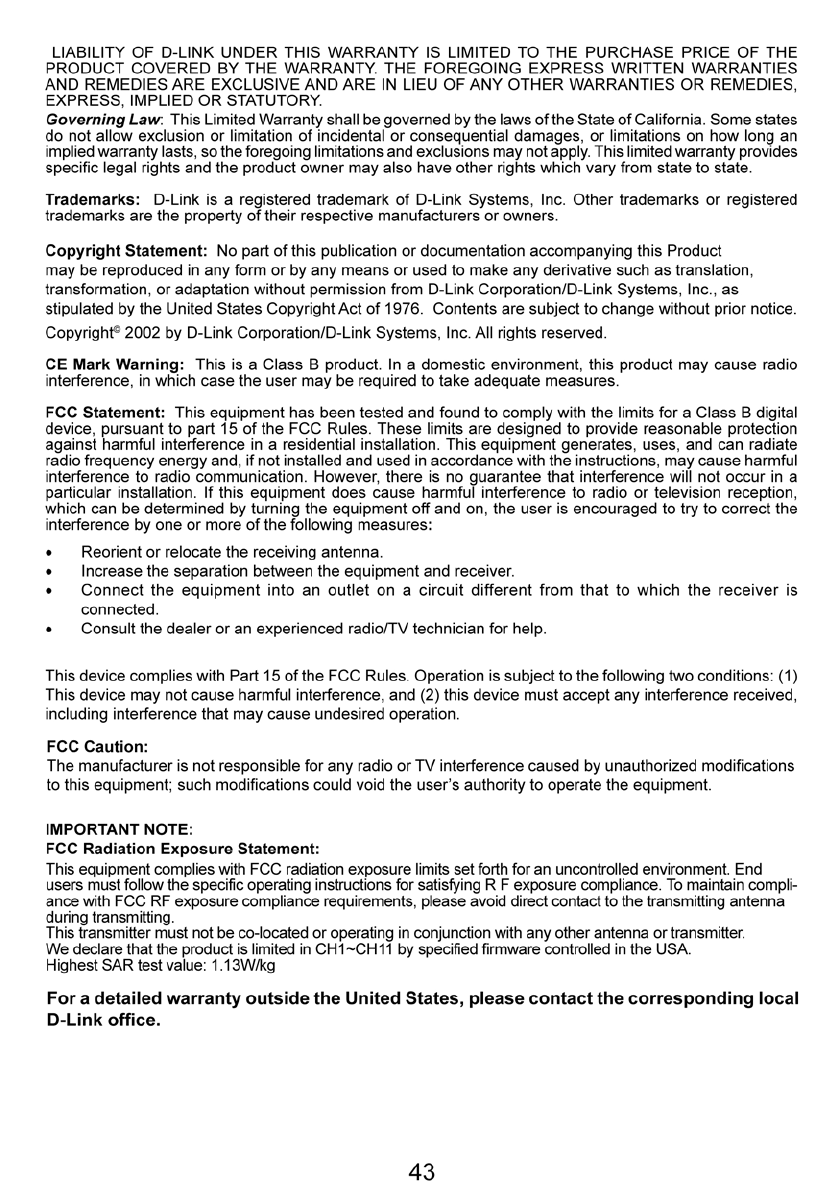

44
Registration
(09/27/2005)